We are experts in customer experience and specialize in
Human centered design. CX transformation CX consultation. UX design. UX workshops. Accessibility.-
Customer and User Experience
are closely related concepts, but their focus and scope differ.
Schedule a consultation
Customer Experience is a set of activities and touchpoints across the entire business (not just on the website or online shop), during which a customer comes into contact with you. From the first banner or spot, to customer support and handling complaints.
User Experience is the part of the whole system that directly concerns the website, usability, intuitiveness, and includes User Interface (UI) and design. -
-
More Info
Customer journey represents a map or visualization of the entire process that a customer goes through when interacting with a brand, product, or service. It focuses on individual touchpoints where the customer comes into contact with the company, from the first moment of interest to subsequent care after purchase.
In design, the customer journey is used to optimize these touchpoints to ensure a smooth, pleasant, and efficient experience for customers. It most commonly includes:
- Awareness
- Consideration
- Decision
- Purchase
- Post-purchase
- Loyalty
Why is UX important?Thanks to research, it is possible to understand the motivations, expectations, or obstacles of real users. It is important to choose the specific research method correctly based on the issue being addressed. Most often, we use the following for our clients:
- Discovery research
- Customer Journey Mapping
- Research with customers
- Focus Groups
- Usability Testing
- UX Audit
more infoWhen is a CX/UX consultation appropriate?
If you encounter the limits of your own team or do not have a similar role in the team, you can take advantage of the advice of our specialists. CX and UX consultation can be one-time, short-term, or even long-term, in the form of personnel leasing.
More infoUX Design
We craft captivating UX designs that guide users effortlessly, ensuring your product is both functional and engaging. Our designs align with your customer needs, directly impacting product success.
We offer wireframes for conceptual visualization and clickable prototypes for usability testing.
The Benefits of Great UX Design
-
Increased user engagement: A positive UX encourages users to spend more time interacting with your product, leading to higher retention rates.
-
Improved conversion rates: A well-designed UX can significantly boost conversion rates, whether it's signing up for a newsletter or making a purchase.
-
Reduced development costs: By identifying and addressing usability issues early in the design process, you can avoid costly rework later on.
What is CRO?
CRO (Conversion Rate Optimization) is the process of increasing the percentage of visitors to your website who perform a desired action – such as making a purchase, filling out a form, or subscribing to a newsletter. While the customer journey maps the entire customer path, CRO focuses on optimizing key moments to turn a visitor into a real customer.
Higher Conversion Rates Thanks to CRO
Our task is to identify obstacles on your site and optimize every touchpoint, so your visitors reach the goal that is important to you. Using data and testing (e.g., A/B tests), we improve texts, graphics, page layout, and overall user experience.
The result is a higher number of conversions without the need to increase traffic, which means more sales and better profit for your business.
What is UX training?
We provide comprehensive UX training that empowers your team to master the art of user-centric design. Our training encompasses the fundamentals of user experience, proficiency in industry-standard design tools like Figma, and the application of practical methodologies like Design Thinking.
Tailored to the specific needs of your team, our training ensures you acquire the skills and knowledge necessary to create exceptional user experiences that drive product success.
What is a CX/ UX Workshop?
CX / UX Workshop can have various goals and purposes. One of them is a joint meeting of designers, stakeholders, and possibly users with the aim of generating ideas, solving problems, and improving the user experience of a product or service.
Who are CX/ UX workshops useful for?
- People who want to learn more about UX design
- UX designers who want to improve their skills
- Entrepreneurs and managers who want to improve the UX of their products or services
- Customer Care for increasing customer satisfaction
- Salespeople and other groups that influence the customer journey
How to design for people?

Analysts, CX consultants, or researchers use quantitative and qualitative research methods, conduct interviews, collect data, analyze questionnaires and other 1st party data, or test the usability of existing solutions and touchpoints.
The goal of this phase is to understand the background, goals, motivations, challenges, as well as the weaknesses that users encounter. In this phase, we often find many problem areas, which we then prioritize.
Phase 2: Hypotheses and Ideas: all the collected data from various areas will subsequently show us the path we should take in solving the problem. From the abundance of data, numerous ideas and hypotheses can arise, which need to be evaluated, compared, and prioritized. In our multidisciplinary team, we bring innovative and user-focused concepts (MVP or PoC) even in collaboration with the client. UX specialists create and explore a wide range of ideas and potential solutions from insights gained through observation.
Phase 3: Prototyping allows designers and UX / CX specialists to easily and quickly verify the clarity and usability of concepts, and to identify potential design issues early on, thus avoiding unnecessary cost increases. In this phase, we can design the scope of solutions in the MVP, define the ideal state, and verify whether customers understand the idea as we expect.
Prototyping is not mandatory, but it is certainly recommended, especially when facing major changes or challenges.
A prototype can take various forms, but we most often use clickable prototypes that realistically mimic the final output, giving the user a real sense of using the service during prototype testing.
Phase 4: Validation or Testing of the proposed solution. Researchers test solutions according to a prepared scenario with real people. Testing can be conducted in various ways and depends on the specific goal or output being tested. The aim of this phase is to identify shortcomings and provide information on possible improvements that will ultimately ensure a better user experience.
Testing, whether of a prototype or another form of output, ensures the effective detection of hidden problems.
Improving UX products & services across all industries
-
Sygic
Redesign for improved usability of the B2B section on the website for the American, English, and German markets based on user research and information architecture design.
-

Asseco
Creating a design system for the client's B2B application interface and marketplace. Emphasis was placed on accommodating the diversity of end users of the design system (such as third-party developers) and its versatility for applications of various purposes (CRM, finance, human resources, etc.).
How does it work at UX Lab?
Watch video
-
250 +
successful projects
-
1000 +
testing
UX design & UI design are a pair of abbreviations that are often mentioned in conjunction with each other. Thanks to UX and UI design a website can keep visitors on its pages. While UX addresses the user's impressions, examines their needs, and identifies problems they have on the site, UI focuses on how to visually and functionally build the website to prevent them. In other words – UX tunes the overall user experience (usability, friendliness, and the needs of the site visitor) and UI how the site looks and functions.
Other ui42's services
Case Studies
UX News
Contact us
Do you want to improve UX of your website?
-

Michaela Recht
Sales Executive
I specialize in:
- UX/CX
- Marketing
-

Samuel Štassel
Sales Executive
I specialize in:
- Development
- AI










































